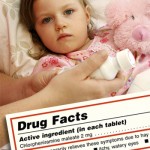 Ah-choo! If your child is sneezing up a storm, it must be allergy season once more. And if your child is taking more than one medication at the same time, there could be dangerous health consequences if those medicines have the same active ingredient, according to Hari Cheryl Sachs, M.D., a pediatrician at the Food and Drug Administration (FDA).
Ah-choo! If your child is sneezing up a storm, it must be allergy season once more. And if your child is taking more than one medication at the same time, there could be dangerous health consequences if those medicines have the same active ingredient, according to Hari Cheryl Sachs, M.D., a pediatrician at the Food and Drug Administration (FDA).
A medicine is made of many components. Some are “inactive” and only help it to taste better or dissolve faster, while others are active. An active ingredient in a medicine is the component that makes it pharmaceutically active—it makes the medicine effective against the illness or condition it is treating.
Active ingredients are listed first on a medicine’s Drug Facts label for over-the-counter (OTC) products. For prescription medicines, they are listed in a patient package insert or consumer information sheet provided by the pharmacist.
Many medicines have just one active ingredient. But combination medicines, such as those for allergy, cough, or fever and congestion, may have more than one.
Take antihistamines taken for allergies. “Too much antihistamine can cause sedation and—paradoxically—agitation. In rare cases, it can cause breathing problems, including decreased oxygen or increased carbon dioxide in the blood, Sachs says.
“We’re just starting allergy season,” says Sachs. “Many parents may be giving their children at least one product with an antihistamine in it.” Over-the-counter (OTC) antihistamines (with brand name examples) include diphenhydramine (Benadryl), chlorpheniramine (Chlor-Trimeton), clemastine (Tavist), fexofenadine (Allegra), loratadine (Claritin, Alavert), and cetirizine (Zyrtec).
But parents may also be treating their children for a separate ailment, such as a cough or cold. What they need to realize is that more than one combination medicine may be one too many.
“It’s important not to inadvertently give your child a double dose,” Sachs says.
Other Health Complications
The same goes for other active ingredients, often found in combination products for allergies but also used to treat other symptoms, such as fever, headache or nasal congestion:
- Acetaminophen (in Tylenol and many other products), a pain reliever often used to treat fevers, mild pain or headache. Taking too much can cause liver damage.
- Ibuprofen (for example, Advil or Motrin), another common medicine for relieving mild to moderate pain from headaches, sinus pressure, muscle aches and flu, as well as to reduce fever. Too much ibuprofen can cause nausea, vomiting, diarrhea, severe stomach pain, even kidney failure.
- Decongestants such as pseudoephedrine or phenylephrine (found in brand name drugs such as Actifed and Sudafed) taken in large amounts can cause excessive drowsiness in children. They can also cause heart rhythm disturbances, especially if combined with products and foods containing caffeine. In the form of nasal sprays and nose drops, these products, as well as oxymetazoline (the active ingredients in products such as Afrin), can cause “rebound” congestion, in which the nose remains stuffy or gets even worse.
Any of the above symptoms may indicate a need for immediate medical attention. “The bottom line is that neither you, nor your children, should take multiple combination medicines at the same time without checking the active ingredients and consulting your health care professional first,” recommends Sachs.
Furthermore, two different active ingredients may serve the same purpose, Sachs says. For example, both acetaminophen and ibuprofen help reduce pain and fever. So there’s generally no need to give your child both medicines for the same symptoms.
Write It All Down
Whether you’re treating your child’s condition with OTC medicines from the drug store or ones prescribed by your doctor, it’s essential that you keep track of every medicine and the active ingredients each contains, Sachs says.
“It’s easy to forget which medicines you’re giving your child,” Sachs says. “And if you have more than one child, it can get even more complicated.” She recommends making it a habit to write down the name of any medicine you give your child, whether it’s OTC or prescription (download a daily medicine records template).
“It’s really a good idea to carry that list with you when you go to see your pediatrician or even when you go to the pharmacy,” she adds. You should also note whatever vitamins or supplements your child is taking, as these can interact unfavorably with certain medicines, too.
Most importantly, Sachs says parents should always read the Drug Facts label on OTC products, and the patient package insert or consumer information sheet that comes with prescription medicines, every time they’re considering a medication for their child, even if they think they already know the ingredients. They should know that the ingredients can change without an obvious change in the packaging. And they should contact their health care professional with any questions. TLS.


I suggest the same for adults…..